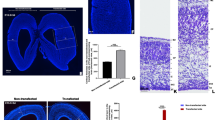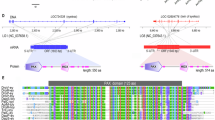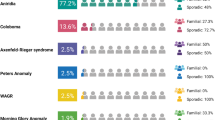Abstract
Control of growth determines the size and shape of organs. Localized signals known as 'organizers' and members of the Pax family of proto-oncogenes are both elements in this control. Pax proteins have a conserved DNA-binding paired domain, which is presumed to be essential for their oncogenic activity. We present evidence that the organizing signal Notch does not promote growth in eyes of D. melanogaster through either Eyeless (Ey) or Twin of eyeless (Toy), the two Pax6 transcription factors. Instead, it acts through Eyegone (Eyg), which has a truncated paired domain, consisting of only the C-terminal subregion. In humans and mice, the sole PAX6 gene produces the isoform PAX6(5a) by alternative splicing; like Eyegone, this isoform binds DNA though the C terminus of the paired domain. Overexpression of human PAX6(5a) induces strong overgrowth in vivo, whereas the canonical PAX6 variant hardly effects growth. These results show that growth and eye specification are subject to independent control and explain hyperplasia in a new way.
This is a preview of subscription content, access via your institution
Access options
Subscribe to this journal
Receive 12 print issues and online access
$259.00 per year
only $21.58 per issue
Buy this article
- Purchase on SpringerLink
- Instant access to full article PDF
Prices may be subject to local taxes which are calculated during checkout







Similar content being viewed by others
References
Martinez, S. The isthmic organizer and brain regionalisation. Int. J. Dev. Biol. 45, 367–371 (2001).
Ohuchi, H. & Noji, S. Fibroblast-growth-factor induced additional limbs in the study of initiation of limb formation, limb identity, myogenesis, and innervation. Cell. Tissue Res. 199, 247–261 (1999).
Irvine, K.D. & Rauskolb, C. Boundaries in development: formation and function. Annu. Rev. Cell Dev. Biol. 17, 189–214 (2001).
Neumann, C. & Cohen, S. Morphogens and pattern formation. Bioessays 19, 721–729 (1997).
Dahl, E., Koseki, H. & Balling, R. Pax genes and organogenesis. Bioessays 18, 755–765 (1997).
Chi, N. & Epstein, J. Getting your Pax straight: Pax proteins in development and disease. Trends Genet. 18, 41–47 (2002).
Das, P. et al. Haploinsufficiency of PAX9 is associated with autosomal dominant hypodontia. Hum. Genet. 110, 371–376 (2002).
Glaser, T. et al. PAX6 gene dosage effect in a family with congenital cataracts, aniridia, anophthalmia and central nervous system defects. Nat. Genet. 7, 463–471 (1994).
Ton, C.T. et al. Positional cloning and characterisation of a paired box- and homeobox-containing gene from aniridia region. Cell 68, 491–505 (1991).
van Heyningen, V. & Williamson, K. PAX6 in sensory development. Hum. Mol. Genet. 11, 1161–1167 (2002).
Cillo, C., Cantile, M., Faiella, A. & Boncinelli, E. Homeobox genes in normal and malignant cells. J. Cell Physiol. 188, 161–169 (2001).
Gnarra, J.R. & Dressler, G.R. Expression of Pax-2 in human renal cell carcinoma and growth inhibition by antisense oligonucleotides. Cancer Res. 55, 4092–4098 (1995).
Scholl, F.A. et al. PAX3 is expressed in human melanomas and contributes to tumor cells survival. Cancer Res. 61, 823–826 (2001).
Winyard, P.J. et al. The PAX2 transcription factor is expressed in cystic and hyperproliferative dysplastic epithelium in human kidney malformations. J. Clin. Invest. 98, 451–459 (1996).
Kroll, T.G. et al. PAX8-PPARgamma1 fusion oncogene in human thyroid carcinoma. Science 289, 1357–1360 (2000).
Maulbecker, C.C. & Gruss, P. The oncogenic potential of Pax genes. EMBO J. 12, 2361–2367 (1993).
Steinbach, J.P., Kozmik, Z., Pfeffer, P. & Aguzzi A. Overexpression of Pax5 is not sufficient for neoplastic transformation of mouse neuroectoderm. Int. J. Cancer 15, 459–467 (2001).
Czerny, T., Schaffner, G. & Busslinger, M. DNA sequence recognition by Pax proteins: bipartite structure of the paired domain and its binding site. Genes Dev. 7, 2048–2061 (1993).
Epstein, J. et al. Two independent and interactive DNA-binding subdomains of the Pax6 paired domain are regulated by alternative splicing. Genes Dev. 8, 2022–2034 (1994).
Kozmik, Z., Czerny, T. & Busslinger, M. Alternatively spliced insertions in the paired domain restrict the DNA sequence specificity of Pax6 and Pax8. EMBO J. 16, 6793–6803 (1997).
Cavodeassi, F., Diez del Corral, R., Campuzano, S. & Dominguez, M. Compartments and organizing boundaries in the Drosophila eye: the role of the homeodomain Iroquois proteins. Development 126, 4933–4942 (1999).
Yang, C., Simon, M.A. & McNeill, H. mirror controls planar polarity and equator formation through repression of fringe expression and through control of cell affinities. Development 126, 5857–5866 (1999).
Cho, K.O. & Choi, K.W. Fringe is essential for mirror symmetry and morphogenesis in the Drosophila eye. Nature 396, 272–276 (1998).
Dominguez, M. & de Celis, J.F. A dorsal/ventral boundary established by Notch controls growth and polarity in the Drosophila eye. Nature 396, 276–278 (1998).
Papayannopoulos, V., Tomlinson, A., Panin, V.M., Rauskolb, C. & Irvine, K.D. Dorsal-ventral signaling in the Drosophila eye. Science 281, 2031–2034 (1998).
Quiring, R., Walldorf, U., Kloter, U. & Gehring, W.J. Homology of the eyeless gene of Drosophila to the Small eye gene in mice and Aniridia in humans. Science 265, 785–789 (1994).
Czerny, T. et al. Twin of eyeless, a second Pax-6 gene in Drosophila, acts upstream of eyeless in the control of eye development. Mol. Cell 3, 297–307 (1999).
Halder, G., Callaerts, P. & Gehring, W.J. Induction of ectopic eyes by targeted expression of the eyeless gene in Drosophila. Science 267, 1788–1792 (1995).
Onuma, Y., Takahashi, S., Asashima, M., Kurata, S. & Gehring W.J. Conservation of Pax 6 function and upstream activation by Notch signaling in eye development of frogs and flies. Proc. Natl. Acad. Sci. USA 99, 2020–2025(2002).
Jun, S., Wallen, R.V., Goriely, A., Kalionis, B. & Desplan, C. Lune/eye gone, a Pax-like protein, uses a partial paired domain and a homeodomain for DNA recognition. Proc. Natl. Acad. Sci. USA 95, 13720–13725 (1998).
Jang, C.C. et al. Two Pax genes, eye gone and eyeless, act cooperatively in promoting Drosophila eye development. Development 130, 2939–2951 (2003).
Hazelett, D.J., Bourouis, M., Walldorf, U. & Treisman, J.E. decapentaplegic and wingless are regulated by eyes absent and eyegone and interact to direct the pattern of retinal differentiation in the eye disc. Development 125, 3741–3751 (1998).
Heberlein, U. & Treisman, J.E. Early retinal development in Drosophila. Fini 2000, 37–50 (2000).
Kurata, S., Go, M.J., Artavanis-Tsakonas, S. & Gehring, W.J. Notch signaling and the determination of appendage identity. Proc. Natl. Acad. Sci. USA 97, 2117–2122 (2000).
Kumar, J.P. & Moses, K. EGR Receptor and Notch signaling act upstream of Eyeless/Pax6 to control eye specification. Cell 104, 687–697 (2001).
Go, M.J., Eastman, D.S. & Artavanis-Tsakonas, S. Cell proliferation control by Notch signaling in Drosophila development. Development 125, 2031–2040 (1998).
Aldaz, S., Morata, G. & Azpiazu, N. The Pax-homeobox gene eyegone is involved in the subdivision of the thorax of Drosophila. Development 130, 4473–4482 (2003).
Brand, A.H. & Perrimon, N. Targeted gene expression as a means of altering cell fates and generating dominant phenotypes. Development 118, 401–415 (1993).
Callaerts, P. et al. Drosophila Pax-6/eyeless is essential for normal adult brain structure and function. J. Neurobiol. 46, 73–88 (2001).
Kronhamn, J. et al. Headless flies produced by mutations in the paralogous Pax6 genes eyeless and twin of eyeless. Development 129, 1015–1026 (2002).
Panganiban, G. & Rubenstein, J.L. Developmental functions of the Distal-less/Dlx homeobox genes. Development 129, 4371–4386 (2002).
Day, S.J. & Lawrence, P.A. Measuring dimensions: the regulation of size and shape. Development 127, 2977–2987 (2000).
Brook, W., Diaz-Benjumea, F. & Cohen, S. Organizing spatial pattern in limb development. Annu. Rev. Cell Dev. Biol. 12, 161–180 (1996).
Serrano, N. & O'Farrell, P.H. Limb morphogenesis: connections between patterning and growth. Curr. Biol. 7, 186–195 (1997).
Azuma, N. et al. Missense mutation in the alternative splice region of the PAX6 gene in eye anomalies. Am. J. Hum. Genet. 65, 656–663 (1999).
Sepp, K.J. & Auld, V.J. Conversion of lacZ enhancer trap lines to GAL4 lines using targeted transposition in Drosophila melanogaster. Genetics 151, 1093–1101 (1999).
Lee, T. & Luo, L. Mosaic analysis with a repressible cell marker for studies of gene function in neuronal morphogenesis. Neuron 22, 451–461 (1999).
Xu, T. & Rubin, G.M. Analysis of genetic mosaics in developing and adult Drosophila tissues. Development 117, 1223–1237 (1993).
Newsome, T.P., Asling, B. & Dickson, B.J. Analysis of Drosophila photoreceptor axon guidance in eye-specific mosaics. Development 127, 851–860 (2000).
Morata, G. & Ripoll, P. Minutes: Mutants of Drosophila autonomously affecting cell division rate. Dev. Biol. 42, 211–221 (1975).
Acknowledgements
We thank N. Azpiazu, V. van Heyningen, H. Sun, S. Bray, J. Treisman, A. Baonza, A. Carmena, J. Casal and P. Callaerts for reagents; Bloomington Stock Center for fly stocks; Developmental Studies Hybridoma Bank for antibodies; I. Gutierrez-García, E. Ballesta-Illan and M. Northcote for technical assistance; and P. A. Lawrence, M. Freeman, D. Page, L. A. Garcia-Alonso, M. Millan, F. Casares and F. Viana for critical reading of the manuscript. Part of this work was done in the laboratory of P. A. Lawrence at the Medical Research Council Laboratory of Molecular Biology in Cambridge (UK). This work was supported by grants from Fondo de Investigaciones Sanitarias and Ministerio de Ciencia y Tecnología from Spain and by a European Molecular Biology Organisation Young Investigator Award to M.D.
Author information
Authors and Affiliations
Corresponding author
Ethics declarations
Competing interests
The authors declare no competing financial interests.
Rights and permissions
About this article
Cite this article
Dominguez, M., Ferres-Marco, D., Gutierrez-Aviño, F. et al. Growth and specification of the eye are controlled independently by Eyegone and Eyeless in Drosophila melanogaster. Nat Genet 36, 31–39 (2004). https://doi.org/10.1038/ng1281
Received:
Accepted:
Published:
Issue date:
DOI: https://doi.org/10.1038/ng1281
This article is cited by
-
PAX6, modified by SUMOylation, plays a protective role in corneal endothelial injury
Cell Death & Disease (2020)
-
Human eye conditions: insights from the fly eye
Human Genetics (2019)
-
Genomic and transcriptomic analysis of the Asian honeybee Apis cerana provides novel insights into honeybee biology
Scientific Reports (2018)
-
The homeodomain of Eyeless regulates cell growth and antagonizes the paired domain-dependent retinal differentiation function
Protein & Cell (2015)
-
Cephalopod eye evolution was modulated by the acquisition of Pax-6 splicing variants
Scientific Reports (2014)



